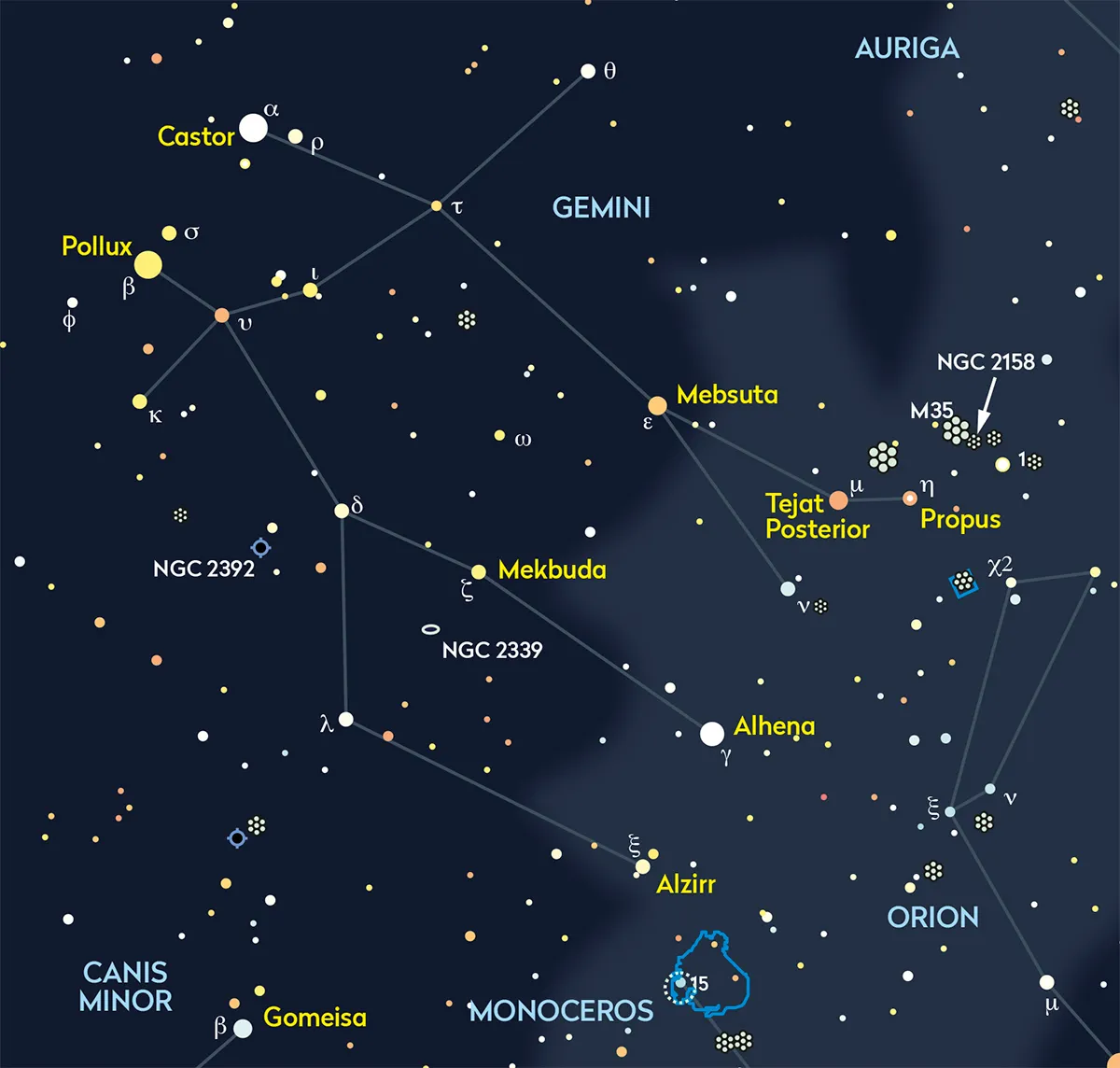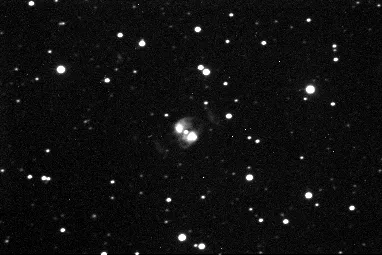Gemini, the twins, is a constellation in the northern hemisphere that can be found sitting between Cancer and Taurus.
The constellation is noted for its two brightest stars Castor and Pollux (Alpha and Beta Geminorum), which mark the heads of the mythological twins.
The constellation Gemini can be found easily by star hopping to it from the constellation Orion.
Find Orion in the night sky, then draw an imaginary line going from Rigel - Orion's right foot, from the viewer's perspective) - through the red star Betelgeuse (Orion's left shoulder).

Continue on and you'll come to two bright stars sitting close to one another. These are Castor and Pollux.
Once you've located Gemini, there are plenty of deep-sky targets to explore with a telescope within the constellation's boundary.
Read on for our pick of 6 of the best deep-sky objects in Gemini.
For help locating the targets, download our chart 6 deep-sky objects in Gemini (PDF).
6 deep-sky objects in Gemini
NGC 2371/72

NGC 2371 is catalogued twice, as NGC 2371 and NGC 2372, a consequence of it appearing as two separate objects. A mag. +11.3 planetary nebula, NGC 2371/72 is located 1.7° north of mag. +3.8 Iota (ι) Geminorum.
A 150mm scope shows a faint haze with an embedded star-like feature. A 250mm scope reveals the dual nature, two lobes connected by a haze, the southwestern lobe brighter and tighter with a star-like core. The central star sits between lobes, requiring a large scope to see at mag. +14.8. The pair are fittingly known as the Gemini Nebula.
NGC 2331

Head 4.6° southwest for open cluster NGC 2331. Also lying 3.1° south and a fraction west of mag. +4.4 Tau (τ) Geminorum,
NGC 2331 is probably best located via mag. +5.8 47 Geminorum, the cluster 1.1° to the west-northwest of this star. NGC 2331 has an integrated magnitude of +8.5, its members scattered across an area slightly larger than the apparent radius of the Moon.
It’s not overly concentrated though and fairly easy to overlook. A 100mm scope reveals around 20 individual stars over an area 19 arcminutes in diameter. NGC 2331 was discovered in 1785 by the English astronomer William Herschel using an 18.7-inch reflecting telescope.
NGC 2341/42

NGC 2341 and NGC 2342 are located 6.7° south and a fraction east of NGC 2331. Your best guide is mag. +4.0 Mekbuda (Zeta (ζ) Geminorum), NGC 2341 lying 1.2° east of this star. Both objects are galaxies, NGC 2342 being slightly brighter at mag. +12.6. It sits 2.6 arcminutes northeast of mag. +13.7 NGC 2341. Through a small instrument, only NGC 2342 is obvious.
A 300mm scope shows an oval glow 1.0 x 0.7 arcminutes in size. The glow only appears to have a very subtle core brightening. NGC 2341 has a similar surface brightness, appearing round in shape with an apparent diameter of 20 arcseconds. Unlike NGC 2342, NGC 2341 appears to brighten towards a tiny core.
NGC 2339

Our next target is NGC 2339, another galaxy. This one is marginally brighter than NGC 2342, with an integrated magnitude of +11.6. It’s located 2.1° south-southeast of Mekbuda and best seen with larger instruments. It was discovered by William Herschel in 1789 and has a low surface brightness due to being face-on.
A 250mm scope shows a roughly circular 1.5-arcminute glow with a bright core. A 300mm scope starts to show mottling, caused by the knotted spiral arms contrasting with the gaps in between them. The core appears around a third of an arcminute across through such an instrument.
NGC 2392

Our penultimate object is one of the more famous deep-sky targets in Gemini: NGC 2392. This bright planetary nebula has an integrated magnitude of +9.2. Visually it has a similar apparent size to Jupiter, covering an area 47 x 43 arcseconds. It’s found 2.3° east-southeast of Wasat (Delta (δ) Geminorum), 0.6° southeast of mag. +5.2 63 Geminorum.
The nebula sits 1.4 arcminutes south of a mag. +8.2 star. A 150mm scope shows it easily, along with its bright mag. +10.5 central star. It appears blue through a 250mm scope and mottled at high magnification. Larger apertures show an extended bright region around the central star.
NGC 2420

NGC 2420 is an eighth-magnitude open cluster visible in small scopes as a 10-arcminute glowing smudge, 2.3° east-northeast of NGC 2392. It sits midway between two ninth-magnitude stars aligned north–south, and two eighth-magnitude stars aligned northeast–southwest. Larger aperture resolves more stars in the glow, a 250mm scope showing 20 members scattered against a 6 x 4-arcminute mottled, elliptical haze.
A 300mm scope almost doubles the number of stars seen, increasing the cluster’s apparent diameter to around 8 x 6 arcminutes. Astrophotography can resolve the cluster stars with relative ease, revealing a cluster occupying much of the 13-arcminute distance between the two north–south aligned ninth-magnitude stars mentioned earlier.
This guide originally appeared in the March 2023 issue of BBC Sky at Night Magazine.

